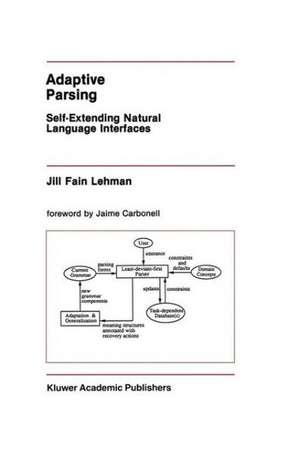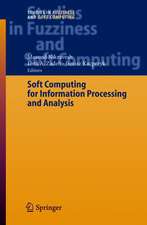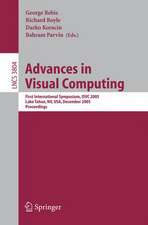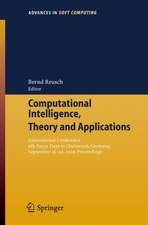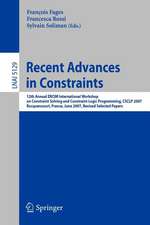Adaptive Parsing: Self-Extending Natural Language Interfaces: The Springer International Series in Engineering and Computer Science, cartea 161
Autor Jill Fain Lehmanen Limba Engleză Paperback – 27 sep 2012
| Toate formatele și edițiile | Preț | Express |
|---|---|---|
| Paperback (1) | 643.63 lei 6-8 săpt. | |
| Springer Us – 27 sep 2012 | 643.63 lei 6-8 săpt. | |
| Hardback (1) | 649.93 lei 6-8 săpt. | |
| Springer Us – 30 noi 1991 | 649.93 lei 6-8 săpt. |
Din seria The Springer International Series in Engineering and Computer Science
- 24%
 Preț: 1041.97 lei
Preț: 1041.97 lei - 20%
 Preț: 643.50 lei
Preț: 643.50 lei - 18%
 Preț: 1225.62 lei
Preț: 1225.62 lei - 18%
 Preț: 965.02 lei
Preț: 965.02 lei - 20%
 Preț: 646.12 lei
Preț: 646.12 lei - 18%
 Preț: 948.79 lei
Preț: 948.79 lei - 20%
 Preț: 646.62 lei
Preț: 646.62 lei - 15%
 Preț: 637.46 lei
Preț: 637.46 lei - 20%
 Preț: 643.83 lei
Preț: 643.83 lei - 18%
 Preț: 949.23 lei
Preț: 949.23 lei - 20%
 Preț: 644.48 lei
Preț: 644.48 lei - 20%
 Preț: 994.92 lei
Preț: 994.92 lei - 20%
 Preț: 645.97 lei
Preț: 645.97 lei - 18%
 Preț: 946.87 lei
Preț: 946.87 lei - 20%
 Preț: 995.57 lei
Preț: 995.57 lei - 18%
 Preț: 956.99 lei
Preț: 956.99 lei - 20%
 Preț: 644.98 lei
Preț: 644.98 lei - 15%
 Preț: 649.54 lei
Preț: 649.54 lei - 18%
 Preț: 950.21 lei
Preț: 950.21 lei - 18%
 Preț: 1221.38 lei
Preț: 1221.38 lei - 18%
 Preț: 957.62 lei
Preț: 957.62 lei - 15%
 Preț: 643.99 lei
Preț: 643.99 lei - 18%
 Preț: 948.47 lei
Preț: 948.47 lei - 18%
 Preț: 947.35 lei
Preț: 947.35 lei - 20%
 Preț: 1284.65 lei
Preț: 1284.65 lei - 20%
 Preț: 1628.31 lei
Preț: 1628.31 lei - 20%
 Preț: 1285.78 lei
Preț: 1285.78 lei
Preț: 643.63 lei
Preț vechi: 804.54 lei
-20% Nou
Puncte Express: 965
Preț estimativ în valută:
123.16€ • 128.93$ • 101.91£
123.16€ • 128.93$ • 101.91£
Carte tipărită la comandă
Livrare economică 05-19 aprilie
Preluare comenzi: 021 569.72.76
Specificații
ISBN-13: 9781461366102
ISBN-10: 1461366100
Pagini: 260
Ilustrații: XV, 240 p.
Dimensiuni: 155 x 235 x 14 mm
Greutate: 0.37 kg
Ediția:Softcover reprint of the original 1st ed. 1992
Editura: Springer Us
Colecția Springer
Seria The Springer International Series in Engineering and Computer Science
Locul publicării:New York, NY, United States
ISBN-10: 1461366100
Pagini: 260
Ilustrații: XV, 240 p.
Dimensiuni: 155 x 235 x 14 mm
Greutate: 0.37 kg
Ediția:Softcover reprint of the original 1st ed. 1992
Editura: Springer Us
Colecția Springer
Seria The Springer International Series in Engineering and Computer Science
Locul publicării:New York, NY, United States
Public țintă
ResearchCuprins
1. Introduction.- 1.1. Natural language interfaces.- 1.2. The dilemma.- 1.3. Towards a solution.- 1.4. The frequent user.- 1.5. Conclusions.- 1.6. Reader’s guide.- 2. System Behavior in an Adaptive Environment.- 2.1. Foundations: Least-deviant-first parsing and MULTIPAR.- 2.2. The model.- 2.3. Assumptions and hypotheses.- 2.4. Adaptation vs. customizable and instructable interfaces.- 2.5. Prior research in adaptation.- 3. User Behavior in an Adaptive Environment.- 3.1. The behavioral hypotheses.- 3.2. The experimental condition.- 3.3. Control conditions.- 3.4. User profiles.- 3.5. Results and discussion.- 4. System Architecture and Knowledge Representation.- 4.1. Representing knowledge in CHAMP.- 4.2. Learning-related knowledge.- 4.3. Application-related knowledge.- 5. Understanding Non-Deviant Utterances.- 5.1. Segmentation.- 5.2. The Coalesce/Expand Cycle.- 5.3. A detailed example: the Coalesce/Expand Cycle for “Can- 89 cel the 3 p.m. speech research meeting on June.”.- 6. Detecting and Recovering from Deviation.- 6.1. Parsing as least-deviant-first search.- 6.2. The cache.- 6.3. Error detection.- 6.4. A detailed example: Error detection during the parse of “Schedule a meeting at 3 pm June 7.”.- 6.5. Error recovery.- 7. Resolution: Choosing Among Explanations.- 7.1. Converting meaning to action.- 7.2. Using default knowledge and inference.- 7.3. Interacting with the databases.- 7.4. Confirmation by effect.- 8. Adaptation and Generalization.- 8.1. Adapting to substitution deviations.- 8.2. Adapting to insertion deviations.- 8.3. Adapting to deletion deviations.- 8.4. Adapting to transposition deviations.- 8.5. A summary of adaptation in CHAMP.- 8.6. Controlling growth in the grammar through competition.- 8.7. The effects of adaptation on performance.- 9.Evaluating the Interface.- 9.1. CHAMP’s performance on the hidden-operator data.- 9.2. CHAMP’s performance in real user interactions.- 9.3. Summary of results.- 10. Critical Issues.- 10.1. The effect of kernel design on learning.- 10.2. The effect of kernel design on search.- 10.3. The effect of search constraints on system predictability.- 10.4. The lexical extension problem.- 10.5. Summary.- 11. Conclusions and Future Directions.- 11.1. Main results.- 11.2. Future directions.- References.
